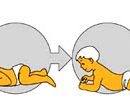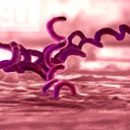What is multiple sclerosis? How dispelled sclerosis is manifested? What is the role of the immune system in the body when developing multiple sclerosis? Read in this article.
Content
Before reading an article about multiple sclerosis, it is important to assimilate that the typical multiple sclerosis does not exist.
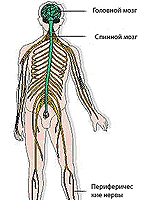 This is a very variable disease that has no predictable or once and forever established current. Symptoms may differ from both different people and the same person after some time. Many people patients with multiple sclerosis continue to live in a normal life and may not experience any symptoms for long periods of time.
This is a very variable disease that has no predictable or once and forever established current. Symptoms may differ from both different people and the same person after some time. Many people patients with multiple sclerosis continue to live in a normal life and may not experience any symptoms for long periods of time.
Scattered sclerosis is characterized by the sudden appearance of symptoms, which is also called exacerbation. Often in a few days or weeks of symptoms weaken, which leads to the full or partial restoration of neurological functions. Such a period is called remission.
Scattered sclerosis is a variable disease that persists in the patient until the end of life. Scattered sclerosis affects many sections of the central nervous system (CNS), which leads to the formation of foci of inflammation and «Blashek» (scars) inside the head and / or spinal cord. The central nervous system (CNS), consisting of a head and spinal cord, works in our body as a control center, controlling muscle movements, collecting and analyzing sensory information that comes from the peripheral nervous system, t.E. Touch and motor nerves. Nervous fibers allow various parts of the body to communicate with each other.
Consider the following example:
When the hand is touching the hot cup, the peripheral nerve endings feel the heat and report this CNS.
CNS decides to give a cup to cool.
Nerve fibers of the peripheral nervous system transmit command muscles hands put a cup back.
Electrical pulses are transmitted through nerves, through which the brain connection is ensured with various parts of the body. The state of the nervous system can be estimated by checking various automatic reflexes. For example, reflexes can be checked by knocking a neurological hammer on the knee or elbow. Evaluation of the reflex function allows you to identify neurological disorders.
Melina value
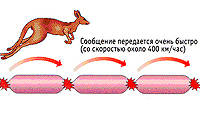 Nervous fibers in the head and spinal cord are covered with an insulating outer layer – Protective shell called Mielin, which is necessary to accelerate the transfer of electrical impulses. Due to the presence of these fat shells, pulses can «jump» From one periodically encountered gap in myelin shell (node) to the next, with the result that messages can be transmitted at high speed.
Nervous fibers in the head and spinal cord are covered with an insulating outer layer – Protective shell called Mielin, which is necessary to accelerate the transfer of electrical impulses. Due to the presence of these fat shells, pulses can «jump» From one periodically encountered gap in myelin shell (node) to the next, with the result that messages can be transmitted at high speed.
Loss of myelin and its consequences
As a result of the inflammatory processes occurring during multiple sclerosis, myelin shells are damaged. Such inflammatory reactions harm not only myelina, but also by oligodendrocytes (cells responsible for the products and preservation of myelin shells axons in the central nervous system). As a rule, the plot of inflammation is easily recognized in the pictures of MRI (magnetic resonance imaging) of the brain.
From damage …
As a result of the absorption of myelin macrophages – «Brigade cleaners» Immune system – Axons of nervous fibers remain bare. However, bare (demyelinized) axons cannot effectively carry out electrical impulses.
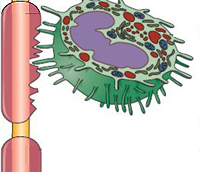 When nerve fibers are denied, t.E. demoelinized, they can start creating «Short circuits» or no longer transmit signals within the nervous system properly. Therefore, when myelin shells are damaged, the impulses go slower than before. At the same time, messages have to be transmitted along the entire length of nerve fibers, which is much slower than when impulses are still moving from one node to another.
When nerve fibers are denied, t.E. demoelinized, they can start creating «Short circuits» or no longer transmit signals within the nervous system properly. Therefore, when myelin shells are damaged, the impulses go slower than before. At the same time, messages have to be transmitted along the entire length of nerve fibers, which is much slower than when impulses are still moving from one node to another.
When the inflammatory process pokes, reparative mechanisms are activated, which sometimes leads to remileinization - restoration of damaged myelin.
Such a cycle of damage and subsequent restoration of nerve fibers in the CNS can be repeated again and again. When inflammation covers a large plot, the resulting scars, called plaques, which can also be detected by MRI method. If inflammation is repeatedly occurring in the same place, the reparative processes may not cope with the restoration of myelin shell, which will lead to an irreversible damage to these nerves.
Thus, the patients with multiple sclerosis have processes of both demyelinization and periodization. Symptoms that will appear in the patient are determined by which section of the head or spinal cord is struck by these plaques.
… To the appearance of symptoms
Symptoms of multiple sclerosis depend on the location of the demyelinization site in the head and spinal cord. These symptoms can differ very much in each individual case, moreover, they are difficult to predict.
Many features of the body can be amazed. Some patients with multiple sclerosis do not experience any symptoms over a long period of time, and this may well be explained by the fact that, despite damage to some nerve paths, the brain is able to fill the damage, overpowers the nerve impulses to alternative nervous paths.
In other cases, there is a link between the affected area of the CNS and the likelihood of symptoms. Therefore, it is important to remember that most patients will experience only some of the most common symptoms of multiple sclerosis.
To frequently encountered symptoms in patients with multiple sclerosis include:
Pathological sensations: Some patients with multiple sclerosis experience strange sensations, such as cold, numbness, tingling or itching.
Visible violations, Such as a blurred vision or loss of color perception, most often, with one eye.
Tired – One of the most common symptoms of multiple sclerosis. A constant feeling of fatigue that does not correlate with the level of neurological deficit or with lesions detected by the MRI method, but is accompanied by depression.
Motor disorders, such as muscle refueling, weakness, muscle loss, spasticity (elevated tone) muscles of extremities.
Coordination disorders – Difficulties when walking or trembling limbs.
Problems with bladder and intestines, For example, problems with the emptying of the bladder and constipation.
Sexual disorders, such as impotence or loss of sensitivity.
Pain – Acute pain (for example, behind the eye) or chronic pain (for example, in limbs or back) – From time to time there are many people suffering from sclerosis.
Such symptoms are able to lead to depression, which often occurs when sclerosis diffuse.
Most of these problems can be reduced using various types of therapy and drugs. You should contact your attending doctor who can recommend an optimal therapeutic approach for your specific situation. Some symptoms are observed often, while others - only in rare cases. Nevertheless, even at the moment when a person has no symptoms, still a hidden activity of multiple sclerosis is possible.
Sclerosis in the body
Scattered sclerosis affects white substance of the head and / or spinal cord. Scattered sclerosis is not infectious and does not necessarily lead to the fact that a person suffering from this disease becomes chained to a wheelchair.
After 25 years, most patients with multiple sclerosis, even in the absence of treatment, still cost without a wheelchair.
The degree of neurological deficit with multiple sclerosis may increase over time, however, the course of this disease and the nature of the symptoms among different people can vary significantly. For this reason, it is important to identify multiple sclerosis at an early stage of the pathological process.
Multiple sclerosis – The role of the immune system
As a rule, the protective mechanism of our organism (immune system) protects against infections of various kinds of. Inflammatory reactions occur when our immune system attacks foreign microorganisms, such as bacteria, viruses, parasites or fungi. White Blood Tales, including Special Immune Cells and Activated Immune Cells «Macrofagi» perform in our immune system the same role as soldiers on the advanced.
Protection against pathogenic «Chuzhakov» coordinate the so-called «T cells» – Key components of the immune system.
However, in rare situations, for example, in autoimmune diseases (prefix «AUTO-» means «mine»), per «Pathogenic strangers» Normal organism cells can be accepted. Then the wandering T-cells for incomprehensible reasons are aimed at their own nervous cells of the body. This happens with painted sclerosis, which is also considered an autoimmune disease. Multiple sclerosis – Only one of many autoimmune diseases. There are other, such as Crohn's disease, psoriasis or rheumatoid arthritis.
«Good guys» become «Bad guys»
Since in the acute phases of multiple sclerosis, there is damage to the hematorecephalic barrier (GEB), the guards of our immune system can penetrate into the brain and by mistake - as with any autoimmune diseases – attack your own body fabric. Thus, the former «good guys» transform B «Bad guys», mistakenly taking your friends (own fabric) for enemies. These attacks lead to damage to the myelin layer, which «eaten» macrophages. Attack macrophadagov – One of the MEELINE Destruction Mechanisms.
As a result of damage to the myelin shell, the message cannot be transmitted on these nervous fibers as quickly as before. Myelin layer – target number one with multiple sclerosis. First, myelin is exposed to attacks, then bare axons are damaged. All this leads to the appearance of symptoms of multiple sclerosis.

